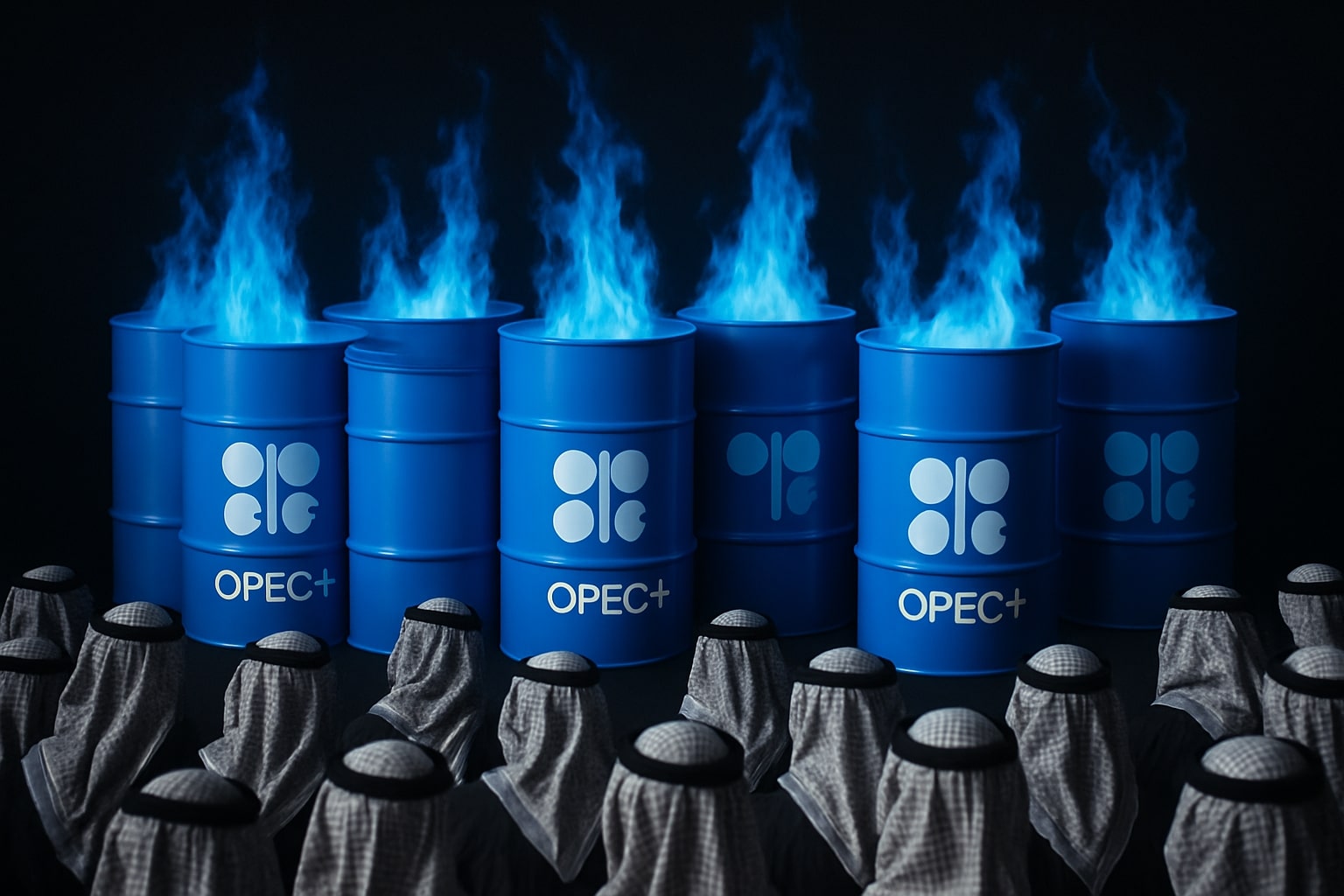
Oil Price Forecast - Oil Prices Strengthen as WTI Touches $60.09 and Brent Climbs to $64.39 on Demand Upgrades
A sharp rebound driven by IEA’s higher demand forecast, a 440,000 bpd global supply drop, Ukrainian strikes on Russian infrastructure, and shifting Asian crude flows helps crude stabilize | That's TradingNEWS
WTI (CL=F) And Brent (BZ=F) Price Rebound Built On Demand Revisions, Supply Friction, And Sanctions-Driven Disruptions
Oil trades in a compressed zone where WTI (CL=F) lifts back toward $60.09 and Brent (BZ=F) stabilizes near $64.39 after markets absorbed a week dominated by shifting demand forecasts, U.S. shutdown dynamics, Russian sanctions volatility, and OPEC+ output adjustments that continue to reshape the supply curve. Momentum recovered sharply after Ukraine struck a major Russian export hub, triggering a 2.75% price spike that reversed the midweek selloff. The rebound is not a clean bullish swing; it is built on layered contradictions—stronger demand projections from the IEA, a 440,000 bpd drop in global output, and yet rising U.S. crude inventories and a 61-rig year-over-year decline in drilling activity all at once. Each of these forces presses directly on CL=F and BZ=F, creating a market where bullish pressure builds aggressively but remains unsteady because the supply overhang has not fully evaporated.
WTI (CL=F) Anchored To $60 As Rig Counts, Inventories, And U.S. Output Define The Lower Band
WTI’s bounce to $60.09 is tightly linked to a three-rig weekly increase that brings the U.S. oil rig count to 417 while remaining 61 rigs below last year’s level. The domestic supply picture is still heavy: U.S. crude inventories climbed 1.5% during the week ending Nov. 7, and daily production surged toward 13.86 million barrels per day, reinforcing why WTI repeatedly struggles to extend above the $60–$62 band without a geopolitical catalyst. Yet the market also knows that rig reductions typically bleed into output with a multi-month lag, making the current rig plateau a potential setup for a winter supply tightening. This tension between immediate oversupply signals and forward-leaning supply contraction is what keeps CL=F pinned in a steady but hesitant grind.
Brent (BZ=F) Stability At $64 Supported By IEA Upgrades And OPEC+ Output Compression
Brent’s move to $64.39 reflects its sensitivity to global expectations. The IEA raised 2025 demand growth forecasts from 710,000 bpd to 790,000 bpd while reporting that global supply dropped 440,000 bpd in October, driven largely by a steep 520,000 bpd reduction within OPEC+ output—Kazakhstan representing the sharpest pullback. At the same time, OPEC’s own numbers showed crude production rising modestly by 33,000 bpd to 28.46 million bpd, illustrating the complex internal dynamics of the cartel. This combination—rising core OPEC production, falling broader OPEC+ output, and diverging forecasts—is exactly why BZ=F trades with more stability than WTI. Brent is pricing a forward tightening rather than the immediate barrels floating onto the U.S. market.
Geopolitical Shockwaves Remain The Fastest Catalyst For Short-Term Volatility Across CL=F And BZ=F
The Ukraine strike that hit a key Russian export hub triggered a rapid 2.75% spike across crude benchmarks as traders recalibrated export risk. The seizure of an Iranian oil tanker in the Gulf of Oman added further pressure, feeding risk premiums into both WTI and Brent. Russia’s export system remains under acute strain—U.S. and European sanctions have stranded nearly one-third of Russian crude at sea. The widening Russian discount, now pushing toward $20 per barrel, signals how severe the sanctions shock has become. This widening chasm in Russian pricing directly supports BZ=F, which competes most closely with Russian Urals, and indirectly props up CL=F by raising global opportunity costs for refiners.
Demand Optimism Returns As U.S. Shutdown Ends, India And China Shift Sourcing, And Seasonal Fuel Use Climbs
With the U.S. government reopening after a 40-day shutdown, aviation travel and fuel consumption expectations rebounded. Seasonal patterns during winter holidays amplify this effect, lifting baseline demand for both gasoline and distillates. India and China also shifted aggressively away from Russian barrels due to sanctions tightening, increasing purchases from the U.S. and Middle Eastern exporters—directly supporting CL=F via rising Gulf Coast flows. The IEA’s improved demand outlook for the U.S., China, and Nigeria added momentum to the bullish case, and markets reacted quickly: WTI rising from $59.15 to $60.06 week over week, and Brent advancing from $63.55 to $64.13 before the later move to $64.39.
Oversupply Fears Persist As Key Agencies Warn Of A 2026 Glut And U.S. Output Retains Upward Pressure
Despite strong demand indicators, oversupply concerns remain potent. OPEC warned that 2026 could present a surplus materially larger than previously expected—an outlook reinforced by the IEA’s updated projections and the EIA’s Short-Term Energy Outlook calling for persistent supply growth. These projections matter because they weigh on long-duration futures positioning and cap the willingness of funds to chase Brent above the $65–$66 zone. This is amplified by U.S. agencies raising their price forecasts for 2025 and 2026—Brent’s average expected at $68.76 and WTI’s at $65.15—yet still predicting price softening from year-end into early 2026. The market understands this as a structural ceiling rather than a short-term prediction. It suppresses exuberance, particularly for CL=F, which remains the most exposed to U.S. production acceleration.
Supply And Refining Patterns Shift As Sanctions Redirect Global Flow Lines And OPEC+ Strategy Remains Divided
Indian refiners pivoting toward U.S. barrels marks a notable break from Gulf dominance, reshaping demand vectors for both WTI and Brent. Meanwhile, U.S. sanctions forced Russian companies to relinquish stakes in key Serbian assets, constraining their downstream reach. The cumulative effect pushes more crude into Atlantic Basin trade routes, reducing available spot cargoes and tightening pricing around BZ=F. At the same time, OPEC+ strategy remains fragmented: some members pushing output higher while others slash production under sanction or operational strain. This uneven approach prevents the cartel from manufacturing a clean price floor but also avoids the steep collapses seen during past unilateral cuts.
Read More
-
SMH ETF: NASDAQ:SMH Hovering at $350 With AI, NVDA and CHIPS Act Fueling the Next Move
16.12.2025 · TradingNEWS ArchiveStocks
-
XRP ETFs XRPI and XRPR: Can $1B Inflows Lift XRP-USD From $1.93 Back Toward $3.66?
16.12.2025 · TradingNEWS ArchiveCrypto
-
Natural Gas Price Forecast: NG=F Falls to $3.80–$3.94 as Warm Winter Kills $5.50 Spike
16.12.2025 · TradingNEWS ArchiveCommodities
-
USD/JPY Price Forecast - USDJPY=X Slides, BoJ 0.50% Hike, Fed Cut and NFP Set the Next Big Move
16.12.2025 · TradingNEWS ArchiveForex
Macro Energy Policy Adds Complexity As Thailand Reevaluates Diesel Caps And Geopolitical Subsidies Shift Regional Demand
Energy governance shifts—such as Thailand reviewing its diesel cap at 30 baht per liter and preparing a new oil crisis plan—highlight how policy reshapes local demand patterns. Subsidy removal deadlines for biodiesel scheduled for 2026 will raise fossil fuel demand elasticity in Southeast Asia. These structural policy changes feed indirectly into global oil dynamics, increasing vulnerability to price swings across CL=F and BZ=F.
Verdict: WTI (CL=F) And Brent (BZ=F) Lean Bullish In Short Cycles But Face Structural Headwinds; Bias = Hold With Selective Bullish Tilt
After full review of all data—IEA’s demand upgrade to +790,000 bpd, global supply drop of 440,000 bpd, 520,000 bpd OPEC+ cut led by Kazakhstan, strong weekly rebound, rising inventories, 13.86M bpd U.S. output, 61-rig YoY decline, sanctions tightening, India and China dumping Russian crude, and repeated retests of $60 and $64—the decision is Hold with near-term bullish bias. WTI’s floor at $59–$60 remains critical; Brent’s support at $63–$64 remains firm. Upside exists toward $62–$64 for WTI and $66–$68 for Brent, but structural 2026 oversupply limits long-term breakout potential.



















